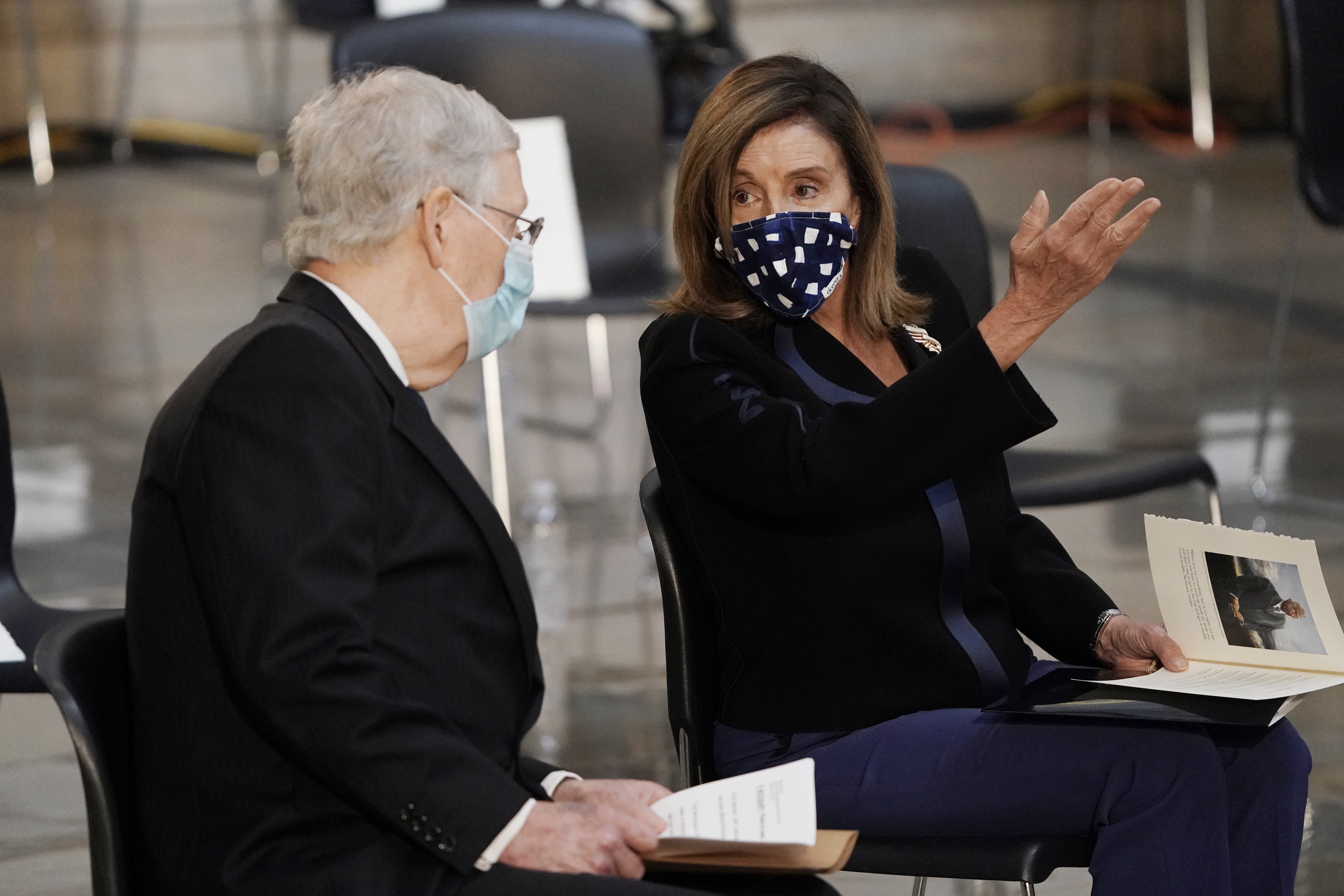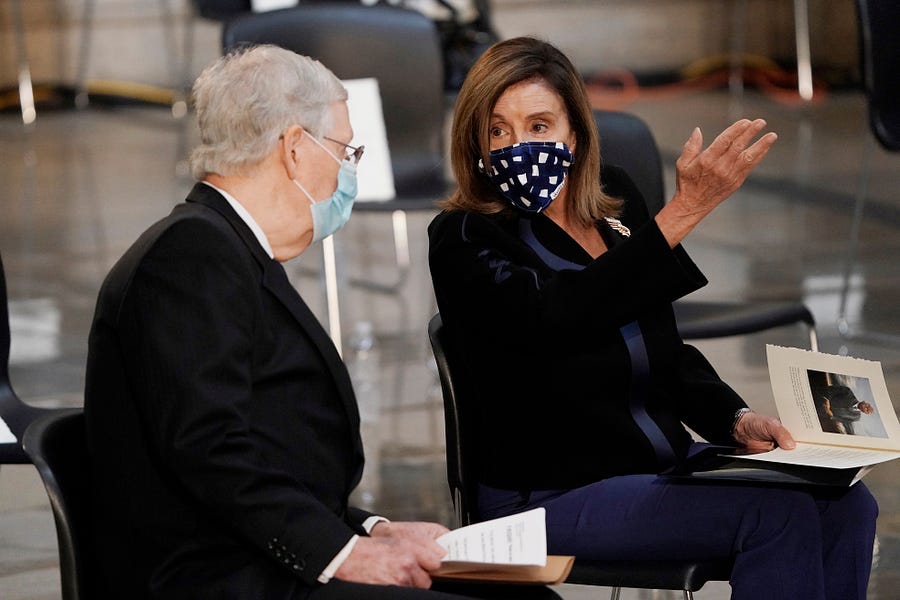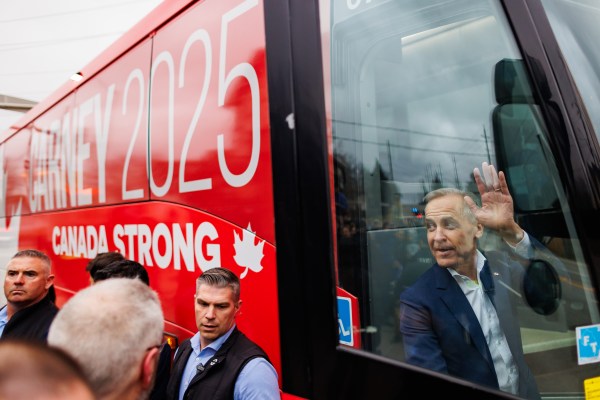Happy Tuesday! We hate to say we told you so, but wasn’t Sarah’s new newsletter great? Sign up for The Sweep by clicking here if you haven’t already.
Quick Hits: Today’s Top Stories
-
The United States confirmed 54,187 new cases of COVID-19 yesterday, with 7.1 percent of the 760,840 tests reported coming back positive. An additional 1,075 deaths were attributed to the virus on Monday—631 of which are the result of Texas catching up on earlier fatalities—bringing the pandemic’s American death toll to 148,009.


-
The White House and Senate Republicans unveiled their $1 trillion coronavirus relief package Monday afternoon. With support from Democrats in the House and Senate required for final passage, the HEALS Act should be viewed more as a starting point for bipartisan negotiations.
-
The first presidential debate of the general election will be moved to Case Western Reserve University in Cleveland after the University of Notre Dame withdrew due to coronavirus concerns.
-
The Trump administration is dispatching an additional 100 federal agents to quell protests and riots in Portland, Oregon, according to an internal email reviewed by the Washington Post. The Department of Homeland Security is reportedly debating sending 50 more U.S. Customs and Border Protection officers to Portland as well.
-
National Security Adviser Robert O’Brien has tested positive for the coronavirus, which he believes he contracted from his daughter. A White House statement says O’Brien “has mild symptoms and has been self-isolating and working from a secure location off site.”
-
Google extended work-from-home status for its nearly 200,000 employees to July 2021 citing coronavirus concerns and uncertainty over school reopenings across the country.
-
Two Major League Baseball games were canceled yesterday, just four days into the fledgling season, after at least 13 players and staff members on the Miami Marlins tested positive for COVID-19. MLB Commissioner Rob Manfred said the league believes it “can keep people safe and continue to play.”
-
Texas Gov. Greg Abbott extended the state’s early voting period by six days, citing the challenges of conducting an election during a pandemic. Texans will now be able to begin early voting on October 13.
-
A week after the White House hoped to signal a new tone in combating the coronavirus, President Trump went on a late-night Twitter spree, retweeting posts claiming Dr. Anthony Fauci and Democrats are suppressing the cure to COVID-19 “to perpetuate Covid deaths to hurt Trump.”
Republicans Unveil the HEALS Act

After weeks of frenetic and fiery deliberations, we’ve finally got our GOP coronavirus proposal on Monday. Senate Majority Leader Mitch McConnell unveiled the $1 trillion package, which now must run the gauntlet against House Democrats determined to spend triple that. Before the haggling starts, here’s a quick look at what’s in it.
Dubbed the Health, Economic Assistance, Liability Protection and Schools (HEALS) Act, the Republican package in large part functions as an extension of the three major coronavirus relief bills that have already been made law this year. It refuels the Paycheck Protection Program and the CARES Act’s fund for forgivable loans to small businesses that continue to make payroll. It includes another round of direct cash payments to individual Americans. And it extends the CARES Act’s federal supplement to state unemployment insurance for people out of work, but at a reduced rate of $200 a week, down from $600.
There are some major new items, too: $105 billion in new funding for education, with much of that earmarked for helping schools reopen for in-person instruction in the fall, and the McConnell priority of a “liability shield” designed to protect businesses from being sued for facilitating the spread of coronavirus unless they can be shown to have acted in a grossly negligent way.
McConnell will undoubtedly have his work cut out for him finding a version of the proposal that can pass both chambers of Congress. Democrats are already savaging it, with Minority Leader Chuck Schumer calling it “a half-hearted, half-baked legislative proposal.” And it’s unclear how much wiggle room he’ll have with his own caucus—part of the reason it took so long to put this package together in the first place was because some Republican lawmakers have said they don’t believe Congress should pass another aid package to begin with.
Squirrelly conservative lawmakers weren’t the only ones the majority leader seemingly had to wheedle into supporting the HEALS Act. The bill contains several head-scratcher provisions that seemingly have practically nothing to do with the task at hand, including $1.75 billion for the FBI to construct a new D.C. headquarters and a provision permitting businesses to fully deduct the expense of business meals. Both provisions were fiercely championed by the White House.
“The president hasn’t pushed for much since the COVID crisis began, but restoring the meals deduction is one idea he has been touting as a way to boost restaurants since the ink on CARES was barely dry,” Liam Donovan, a former GOP aide, told The Dispatch. “The only thing he has been louder or more consistent about has been a payroll tax cut, and with that idea slipping out of the proposal altogether, the meals deduction is a way to give the president something he can think of as a personal win in the GOP’s opening bid.”
President Trump has shown before that he doesn’t always feel bound by a handshake agreement with his party’s lawmakers. In January 2019, after reaching a similar negotiating agreement with McConnell over a government funding bill, Trump decided to blow it up at the last minute because it did not sufficiently fund his border wall. That gambit triggered the longest government shutdown in American history. No shutdown is imminent here, but with the virus resurgent and the economy still struggling, the stakes are just as high.
“Having the president’s full-throated support for the Senate package is crucial to the Republican negotiating position, particularly at this stage, so a policy sop that may or may not make the final bill is a small price to pay for intraparty comity,” Donovan said. “Give him nothing he can view as a personal win, and he could make life very difficult.”
What Will College Look Like in the Fall? It Depends.
As Democrats and Republicans increasingly cling to K-12 school reopenings as ammunition in their political offensives, colleges and universities have largely been left to their own devices as they formulate a way forward this fall. The recent surge in new coronavirus cases around the country has institutions of higher education trying to implement creative solutions for reopening with the help of experts, community leaders, and their own student bodies.
The Chronicle of Higher Education is tracking more than 1,260 colleges as they form plans to offer coursework to students. As of Monday evening, slightly less than 50 percent of schools included in the study are preparing to open for in-person education come fall. The data also show that 35 percent will operate on a hybrid model, 13 percent will go entirely virtual, and about 3.5 percent have yet to reach a final decision.
With millions of families struggling to meet their various financial commitments amid a recession, some colleges have extended at least a modicum of financial relief. The College of William & Mary, Kansas City University, and Virginia Tech have all instituted tuition freezes, pledging not to raise tuition and fees the usual 3 percent during this academic year. The University of Nebraska—which is moving forward with many in-person courses—has offered to waive tuition and fees for students from families making less than $60,000 per year.
Several schools switching to virtual courses will reduce tuition in response to pressure from parents and students. Georgetown University and Lafayette College both announced that they will cut tuition by 10 percent to compensate for the less-than-ideal transition to Zoom instruction. Princeton University—which plans to invite back half of its undergraduate population each semester—also promised to cut tuition by 10 percent.
By and large, however, most colleges and universities—even those going entirely remote—will not offer tuition and fee discounts. Many private and public institutions are reeling from the economic downturn along with the rest of the country and lack the financial resources to offset student costs. Some schools, like MacMurray College in Illinois, have already announced plans to close their doors for good.
Several universities—more than 400 according to the study above—have proposed hybrid learning solutions to bring students back without overcrowding their campuses. Yale University, for example, plans to reduce its student population by reopening without sophomores on campus in the fall and without freshmen on campus in the spring. The University of Virginia and Southern Methodist University will both reopen in August but allow students to choose between in-person, online, or hybrid coursework.
Some schools made one set of plans, only to have the coronavirus render them obsolete. UC-Berkeley initially adopted a hybrid approach, but switched gears to go fully remote to start the year as new COVID-19 cases surge in California. “After weeks of developing a very elaborate plan for a hybrid model in the fall, we decided after we had a serious fraternity outbreak, that it was just too risky to teach face to face,” Chancellor Carol Chris said in an announcement last week. UC-Merced has made the same decision.
Schools moving ahead with the fall semester hope that precautionary measures and creative thinking will allow students to enjoy the benefits of an in-person education while limiting the downside risk.
“A committee of students, faculty and staff are developing opportunities and programs to engage students in the new normal of campus life,” Tulane President Michael A. Fitts told The Dispatch. The university consulted experts from internal organizations—like their medical school and school of public health—and external sources like the CDC, WHO, and Louisiana Department of Health before opening to students.
Colby College—a private school of just around 2,000 undergraduates in Maine—will spend $10 million on a reopening strategy involving comprehensive and successive testing for students, faculty, and staff. Doug Terp—the school’s chief financial officer and head of Colby’s COVID-19 task force—told The Dispatch that the college has been working with Dr. Michael Mina of Harvard’s T.H. Chan School of Public Health to fight the spread of coronavirus from all angles.
The school will administer around 85,000 tests over the course of the semester, contact trace, surveillance test, enforce a mask mandate, and provide separate housing for students who test positive for coronavirus. “You can’t do any one of these things. They all fit together. You need the rules, the face masking, the daily check, and the testing, all of this is integrated,” Terp explained.
Ultimately, the effectiveness of college reopenings hinges on student cooperation. While social distancing and mask wearing will be stringent in university settings, students need to avoid the temptation to gather in large groups to prevent the virus’s spread. And on that there’s reason for some cautious optimism, as Sam Abrams wrote earlier this month.
Worth Your Time
-
A natural instinct in today’s political environment is to deal entirely in absolutes, leaving little room for nuance. Recent events in Portland, Oregon, are no exception. All the protesters in the city are either valiant martyrs or violent anarchists hell-bent on overthrowing the existing social order. All the law enforcement agents deployed to protect the federal courthouse are either authoritarian goons or heroic civil servants saving the City of Roses from destruction. But the best reporting works to tease out the contradictions in a story, and this saga features plenty of gray areas. “We are not here being violent or being destructive. We have a positive message — there is nothing to quell here,” a protester told Mike Balsamo and Gillian Flaccus in their on-the-ground reported piece for the Associated Press. “Thirty minutes later, someone fired a commercial-grade firework inside the fence. Next came a flare and then protesters began using an angle grinder to eat away at the fence. A barrage of items came whizzing into the courthouse: rocks, cans of beans, water bottles, potatoes and rubber bouncy balls that cause the agents to slip and fall. Within minutes, the federal agents at the fence perimeter fired the first tear gas of the night.” Read the whole piece—and Balsamo’s accompanying Twitter thread—for an unparalleled look at what is actually happening in a city that both “sides” are hoping to exploit for political purposes.
-
Writing in the New York Daily News, former national security adviser John Bolton argues that contrary to conventional wisdom, Donald Trump has been weak on China. In pursuit of his much-cherished trade deal, “Trump sneered at concerns about Beijing’s belligerence in the South China Sea; its intentions to subjugate Taiwan; repression of the Uighurs; the shredding of China’s pledge to maintain Hong Kong’s separate status after the ‘handover’ from Great Britain; and more.” On COVID-19, “at first, Trump simply ignored Beijing’s culpability. China’s disinformation, concealment and willful misrepresentation went unanswered… On Jan. 24, for example, Trump tweeted cravenly: ‘China has been working very hard to contain the Coronavirus. The United States greatly appreciates their efforts and transparency. It will all work out well. In particular, on behalf of the American People, I want to thank President Xi!’” While Trump has toughened his approach to China as he seems to cast Joe Biden as weak, the real concern, Bolton says, is what Trump would do in a second term.
-
Two pieces published yesterday highlight the scientific uncertainty and rapidly evolving research surrounding the coronavirus. First, Katherine Wu in the New York Times details an upcoming study from UCSF and Johns Hopkins researchers that finds not only does an individual wearing a mask protect others, it might protect the wearer itself—either by preventing infection entirely or lessening the severity of the symptoms by reducing the viral load ingested. Next, The Atlantic’s Derek Thompson dug into what he deems “hygiene theater,” our newfound obsession with deep cleaning and disinfecting ourselves and our surroundings despite pretty convincing evidence that COVID-19 spreads primarily through the air, not surfaces (though surface transmission is not impossible, wash your hands!). “Money that could be spent on distributing masks, or on PSA campaigns about distancing, or actual subway service, is being poured into antiseptic experiments that might be entirely unnecessary,” Thompson writes.
-
CNN legal analyst and Supreme Court biographer Joan Biskupic is out with an exhaustive piece on John Roberts’s tumultuous year as chief justice. Roberts’ recent rulings on a wide range of cases have surprised liberals and conservatives alike—and CNN’s reporting provides a host of interesting inside details and previously unknown background information about the conditions that led to those decisions.
Presented Without Comment
Presented Without Comment
Also Presented Without Comment
Toeing the Company Line
-
Chief Justice John Roberts joined the four liberal justices on Friday in denying a Nevada church’s application for injunctive relief over coronavirus restrictions. Sarah and David have some thoughts. Catch the latest episode of Advisory Opinions to get their insights on all things SCOTUS, including some revisionist history on a hypothetical Merrick Garland Supreme Court tenure and Sen. Josh Hawley’s crusade to save legal conservatism.
-
On the site today, Samuel J. Abrams shares some data that shows we shouldn’t fall back on regional cultural tropes to claim that some areas are more responsible in their pandemic response. In reality most Americans are wearing masks, social distancing, and trying to get through this pandemic thing together
Let Us Know
Do you have college-aged children, or are you a college student yourself? What’s the plan for this fall?
Reporting by Declan Garvey (@declanpgarvey), Andrew Egger (@EggerDC), Sarah Isgur (@whignewtons), Charlotte Lawson (@charlotteUVA), Audrey Fahlberg (@FahlOutBerg), Nate Hochman (@njhochman), and Steve Hayes (@stephenfhayes).
Photograph by J. Scott Applewhite/Pool/Getty Images.







Please note that we at The Dispatch hold ourselves, our work, and our commenters to a higher standard than other places on the internet. We welcome comments that foster genuine debate or discussion—including comments critical of us or our work—but responses that include ad hominem attacks on fellow Dispatch members or are intended to stoke fear and anger may be moderated.
With your membership, you only have the ability to comment on The Morning Dispatch articles. Consider upgrading to join the conversation everywhere.